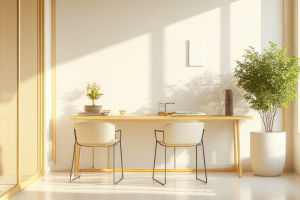It might come down to scale and proportion—two design basics that can make or break how a space feels. Even if your furniture is gorgeous and your colors are perfect, mismatched sizes can throw the whole room out of balance.
This guide will help you understand how to pick the right pieces for your space, so everything feels just right.
The Power of Scale
Before you fall in love with a giant armchair or a teeny-tiny side table, let’s chat about scale. This concept refers to how big or small something is in relation to the space around it—and getting it right is a game changer.
Measure Your Space First
Start with a tape measure. Know the length, width, and height of your room before you buy anything. This gives you a solid foundation to work from, and helps you avoid squeezing in furniture that’s too large or cluttering the space with items that are too small.
Sketch a rough layout if you need to, or use simple floor planning apps. They’ll help you visualize how everything fits, especially if you want to try different arrangements.
Choose Furniture That Matches the Room’s Volume
Think of your room as a container. A large sectional might be perfect in a wide living room but will overwhelm a narrow space. On the flip side, a dainty chair can disappear in a big, airy room.
Aim for pieces that feel comfortable in their space—not too dominant, not too shy. Look at ceiling height, wall length, and available walking space when choosing. If your ceilings are low, go for furniture with lower backs. This keeps the eye moving smoothly around the room.
Leave Room to Breathe
When furniture hugs every inch of the room, the space can feel crowded. Leave some open floor around your key pieces, especially in walkways. This not only improves flow but also lets your design choices shine.
You don’t need a big room to create an airy vibe—you just need the right balance of space and furniture.
Proportion Brings Harmony
Once the scale of your furniture fits the room, it’s time to make sure the pieces relate to each other. That’s where proportion steps in.
Match Heights and Widths Thoughtfully
Pay attention to how your furniture and decor items relate to each other. For example, a lamp should feel right sitting next to a sofa—not towering over it or getting lost. Side tables should be roughly level with nearby seating for comfort and cohesion.
When arranging artwork above furniture, the width of the art should usually be around two-thirds the width of the furniture below it. This kind of visual relationship helps everything feel balanced.
Group Décor Items by Proportional Sets
When you’re styling shelves or tabletops, group items in varying heights but similar proportions. Three vases of different sizes can look great if they feel like they belong in the same family—just like stacking books and topping them with a plant adds visual interest without clashing.
Avoid filling every surface edge-to-edge. Negative space gives your eyes a rest and makes your favorite pieces pop.
Layer with Intention
Layering is a wonderful tool, especially when done with scale and proportion in mind. For example, start with a large area rug, add a mid-sized coffee table, then place a smaller tray or plant on top. You’re creating visual steps that draw attention in and guide the eye around the space.
You can also layer wall elements—like a large mirror with a small frame beside it—to keep things dynamic without creating chaos.
Dear Lykkers, designing with scale and proportion is like creating a well-composed song. Every piece plays a part—and when they’re in sync, the result is a beautiful, comfortable, and visually satisfying space. You don’t need a degree in design to get it right. Just keep an eye on how things fit together, both with the room and with each other.
The next time you shop for a new piece, pause and ask yourself: “Will this feel good here?” If the answer is yes, you’re already designing like a pro.


